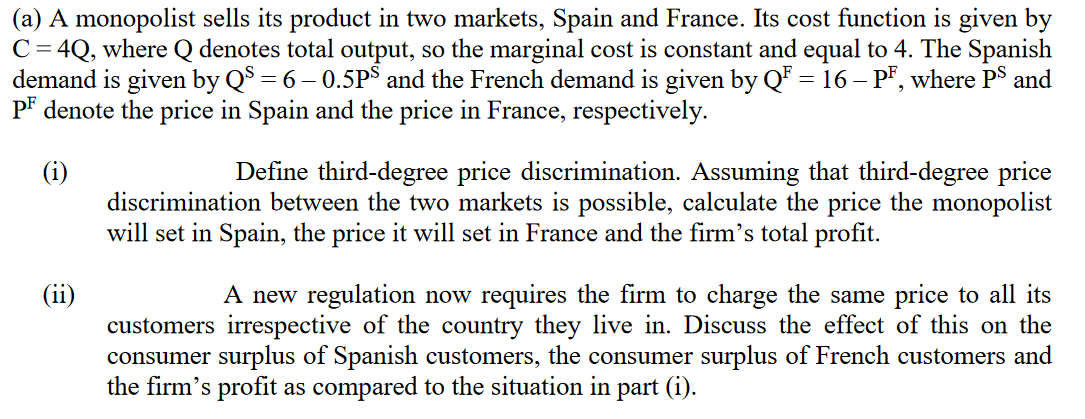(a) A monopolist sells its product in two markets, Spain and France. Its cost function is given by C = 4Q, where Q denotes total output, so the marginal cost is constant and equal to 4. The Spanish demand is given by QS = 6 -0.5PS and the French demand is given by Q³ = 16 – P³, where PS and PF denote the price in Spain and the price in France, respectively. - (i) (ii) Define third-degree price discrimination. Assuming that third-degree price discrimination between the two markets is possible, calculate the price the monopolist will set in Spain, the price it will set in France and the firm's total profit. A new regulation now requires the firm to charge the same price to all its customers irrespective of the country they live in. Discuss the effect of this on the consumer surplus of Spanish customers, the consumer surplus of French customers and the firm's profit as compared to the situation in part (i).
(a) A monopolist sells its product in two markets, Spain and France. Its cost function is given by C = 4Q, where Q denotes total output, so the marginal cost is constant and equal to 4. The Spanish demand is given by QS = 6 -0.5PS and the French demand is given by Q³ = 16 – P³, where PS and PF denote the price in Spain and the price in France, respectively. - (i) (ii) Define third-degree price discrimination. Assuming that third-degree price discrimination between the two markets is possible, calculate the price the monopolist will set in Spain, the price it will set in France and the firm's total profit. A new regulation now requires the firm to charge the same price to all its customers irrespective of the country they live in. Discuss the effect of this on the consumer surplus of Spanish customers, the consumer surplus of French customers and the firm's profit as compared to the situation in part (i).
Managerial Economics: Applications, Strategies and Tactics (MindTap Course List)
14th Edition
ISBN:9781305506381
Author:James R. McGuigan, R. Charles Moyer, Frederick H.deB. Harris
Publisher:James R. McGuigan, R. Charles Moyer, Frederick H.deB. Harris
Chapter16: Government Regulation
Section: Chapter Questions
Problem 10E
Related questions
Question

Transcribed Image Text:(a) A monopolist sells its product in two markets, Spain and France. Its cost function is given by
C = 4Q, where Q denotes total output, so the marginal cost is constant and equal to 4. The Spanish
demand is given by QS = 6 – 0.5PS and the French demand is given by QF = 16 - PF, where PS and
PF denote the price in Spain and the price in France, respectively.
(i)
(11)
Define third-degree price discrimination. Assuming that third-degree price
discrimination between the two markets is possible, calculate the price the monopolist
will set in Spain, the price it will set in France and the firm's total profit.
A new regulation now requires the firm to charge the same price to all its
customers irrespective of the country they live in. Discuss the effect of this on the
consumer surplus of Spanish customers, the consumer surplus of French customers and
the firm's profit as compared to the situation in part (i).
Expert Solution
This question has been solved!
Explore an expertly crafted, step-by-step solution for a thorough understanding of key concepts.
This is a popular solution!
Trending now
This is a popular solution!
Step by step
Solved in 4 steps

Knowledge Booster
Learn more about
Need a deep-dive on the concept behind this application? Look no further. Learn more about this topic, economics and related others by exploring similar questions and additional content below.Recommended textbooks for you

Managerial Economics: Applications, Strategies an…
Economics
ISBN:
9781305506381
Author:
James R. McGuigan, R. Charles Moyer, Frederick H.deB. Harris
Publisher:
Cengage Learning

Managerial Economics: Applications, Strategies an…
Economics
ISBN:
9781305506381
Author:
James R. McGuigan, R. Charles Moyer, Frederick H.deB. Harris
Publisher:
Cengage Learning